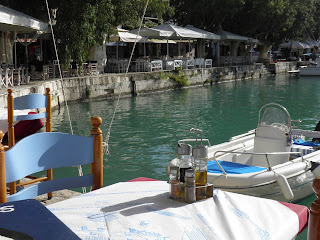Traditionaly at greek tables beetroot are eaten with a garlic sauce (skordalia) . Also any 'ray' sort of fish is eaten with skorthalia. We had both so garlic sauce was made, by me.
Here we eat all of the beetroot plant. The leaves are boiled separately from the bulbs. The stalks are cut up and added first to the boiling water. I cook the beetroot bulb whole. The peel just slides off afterwards. My sister-in-law however peels the beetroot like a potato and cubes and cooks it. Whatever way you do it the vegetable water is full of nutriments and perfect for watering the garden - when it has cooled.
The garlic sauce is made from bread softened in water and I also add a small boiled potato. It makes the sauce smoother.
To the squeezed out bread is added lots of crushed garlic. I actually added two more pieces of garlic.
Put it into your little mixer and whizz it well with a good dash of vinegar, olive oil and salt. It can get cloggy and may even burn out the mixer-motor. I whizz it in batches and then mix it altogether in a big bowl. If you're using potato then be even more careful. If it seems dry then add a little water.
These are the pieces of the wing of the 'ray'. Sting ray, sun ray. (skate?) They are usually about half a metre across and have wing like fins. They are very popular here. Just flour, season and fry.
If you have fished it up yourself then it needs the skin removing. Not so easy. It also has, not bones, but sort of geletinous strands (cartilage) which can be chewed and removed from mouth in a genteel manner (as opposed to being spat out into a paper napkin which is what most often happens here).
All in all the combination is rather tasty, the beetroot, the sauce and the fish.
Word of the day:
aggravistle - that small and inaccessible piece of steak (or gelatinous cartilage in this case) that sticks between the teeth and cannot be dislodged despite constant agitation, causing great discomfort and annoyance.
Who knew there was a word for it.




























































.png)






















